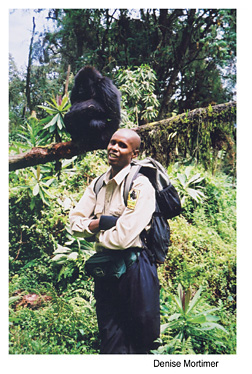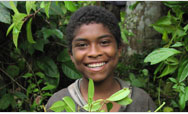 |
Protected Areas Management
Protected areas are tracts of forest, mountains, wetlands, grasslands, deserts, lakes, rivers, coral reefs, and even oceans that are managed to maintain the Earth’s biodiversity. Because habitat loss is a serious threat to biodiversity, establishing protected areas as safe havens for biodiversity is critical to ensuring the survival of the Earth’s natural heritage.
 |
A park ranger in Rwanda monitors Mountain
gorilla behavior and health with support from
USAID partners. |
Most protected areas are managed for multiple, yet compatible uses. Protected areas can have many management objectives beyond biodiversity conservation, including outdoor recreation, tourism, watershed protection, sustainable forestry, hunting or fishing, scientific research, and environmental education.
Establishing a protected area requires more than simply setting aside a track of land for “protection.” A protected area requires a management plan to ensure that biodiversity is in fact protected. To be effective, the plan must address the various threats to the area and the biodiversity it supports. Threats to any given protected area might include the conversion of habitat to agriculture, unsustainable extraction of resources, illegal logging and poaching, the introduction of invasive or alien species, pollution, and climate change.
Biological scientists (such as biologists) play an important role in developing management plans by addressing the ecological issues related to conservation. Social scientists (such as anthropologists, economists, and political scientists) are playing an increasingly greater role in helping protected area managers address the social issues related to conservation. Understanding the behavior of the individuals and communities who live in or around protected areas is critical to ensuring the protected areas’ success in conserving biodiversity. As a result, conservation efforts often extend beyond the borders of protected areas.
In recognition of the important role played by protected areas in conserving biodiversity, USAID helps developing nations improve protected area management. For example, in Latin America, USAID is supporting the Parks in Peril Program in partnership with The Nature Conservancy, local nongovernmental organizations, and local governments. The program is an emergency effort to safeguard the most threatened ecosystems in the Latin American and Caribbean Region. Since 1990, the program has worked to improve the protection of 37 critically threatened national parks and reserves covering more than 11 million hectares and containing biodiversity of global significance.
More information about USAID’s approach to Protected Areas Management can be found in USAID’s Biodiversity Conservation Guide (6.81MB PDF).
For more information about Protected Areas around the world, visit:
Back to Top ^
|


